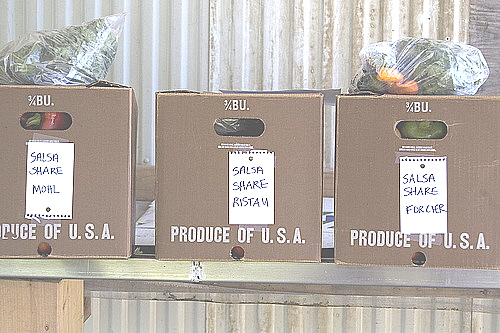Management & Marketing
Marketing Models
CSA
Since 2006, the Loon Organics CSA has provided half or more of Laura and Adam’s direct-market sales. This enterprise has been their most profitable. They have found a high demand for CSA, both when in proximity to the Minneapolis-St. Paul metropolitan area and now on the outskirts of Hutchinson, a town of about 13,000.
The number of shares they offer has grown each year (Table 5). They anticipate offering a maximum of 175-200 shares in the future. Their subscription covers an 18-week period from mid-June through mid-October. Starting in 2009, they offered a separate Thanksgiving CSA box in November. They also offered “preserving shares,” or extra boxes of product sold to existing members during the fall at wholesale prices. The boxes contained surplus greens, tomatoes, or themed combinations called “salsa shares” or “pesto shares,” an idea gleaned from the previous farm owners (Figure 50).
CSA Year |
2006 |
2007 |
2008 |
2009 |
% of Direct Sales |
61.9 |
49.2 |
54.6 |
73.0 |
# Shares Offered |
35 |
40 |
60 |
125 |
| Farmer’s Perspective: On the Bookshelf Sharing the Harvest: A Citizen's Guide to Community Supported Agriculture by Elizabeth Henderson and Robyn Van En This resource is the closest thing Laura and Adam have found to a “bible” of CSA farming. Why Laura likes it: “It has tons of great information for new and old CSA growers alike. It is also written geared towards citizens that would like to form a CSA themselves and hire a farmer to grow food for them. Elizabeth and Robyn were at the forefront of founding some of the first CSA farms in the U.S. The book was recently revised and expanded, and at the end of the book there is a list of comprehensive CSA Resources.” |
 |
Figure 50: Adam and Laura offered extra shares to their CSA customers due to a good harvest in the fall of 2009. |
Laura and Adam have built their CSA member base by using their Web site, posting at Local Harvest and other sources, and relying on word of mouth.
Although the CSA requires a substantial investment of time because of the customer service, administrative duties, and communication skills involved, they like that most of the marketing effort can be done in the off-season rather than taking hours from the growing season. Duties during the season include preparing a weekly newsletter; handling phone and e-mail correspondence; arranging and conducting farm visits, tours, and farm gatherings; processing payments; and conducting surveys.